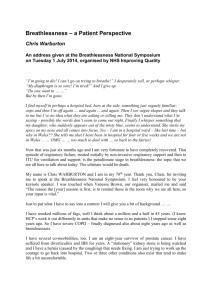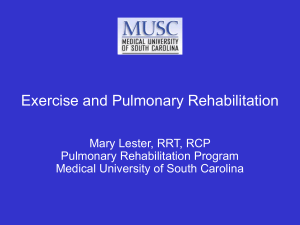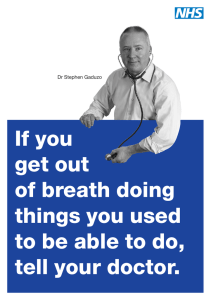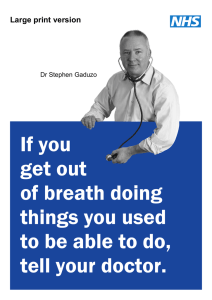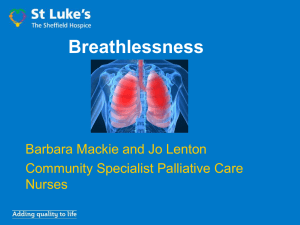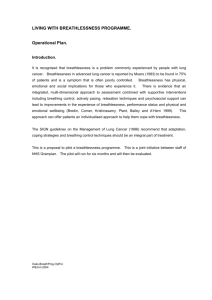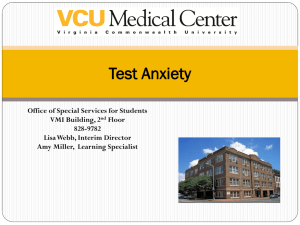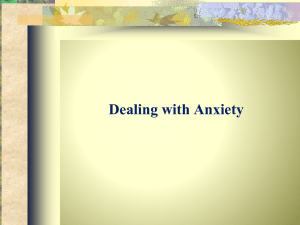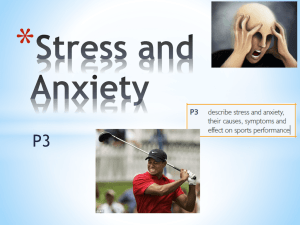Management of Breathlessness
advertisement
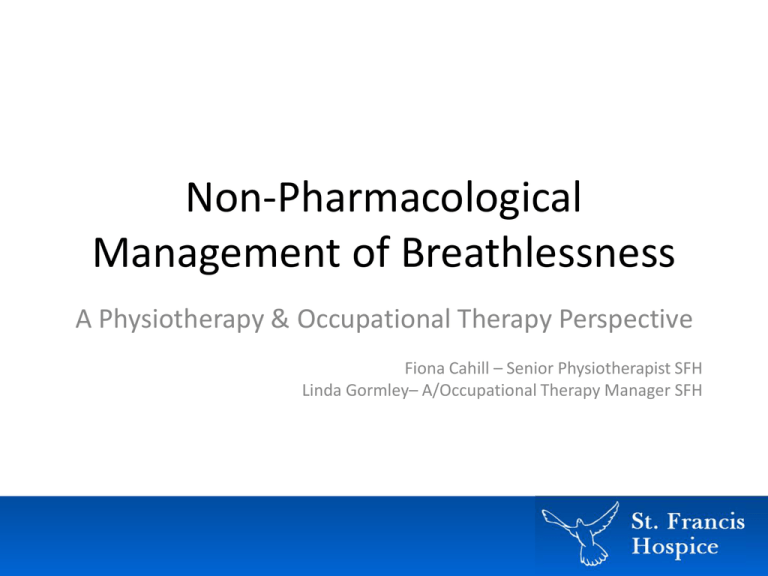
Non-Pharmacological Management of Breathlessness A Physiotherapy & Occupational Therapy Perspective Fiona Cahill – Senior Physiotherapist SFH Linda Gormley– A/Occupational Therapy Manager SFH Introduction • Breathlessness can be a terrifying and exhausting symptom for palliative care patients, therefore a collaborate approach enables professional/patients to work towards a common goal( Syrett & Taylor 2003) Interdisciplinary working • Physio and OT play an important role in the nonpharmacological management of breathlessness • Both disciplines have core skills which when successfully integrated can enhance best practice/patient care • Collaborative working between the two disciplines lends itself to a holistic approach • NICE guidelines for the management of Lung Cancer recommend access to nonpharmacological interventions Types of breathlessness • Activity induced breathlessness • Anxiety induced breathlessness • Medical conditions – Chest Infections – Acute Cardiac conditions ACTIVITY INDUCED BREATHLESSNESS • Breathlessness is a normal response to exercise / activity • Exercise tolerance varies depending on age, illness and previous activity levels • With illness, people are anxious re exercise and then to avoid it Sensation of SOB ↑effort required Muscle weakness develops Avoid activity ↓ cardiovascula r fitness Borg Breathlessness Scale Rating Severity Can you ....... 0 No Breathlessness Sing / whistle 0.5 Very Very Slight (just noticeable) Sing / whistle 1 Very Slight Sing/whistle Slight Talk comfortably 1.5 2 2.5 Talk but aware of your breathing 3 Moderate Say short sentences 4 Somewhat severe Say 2 – 3 word answers 5 Severe Say one word answer Very Severe Occasionally say one word answers 9 Very very severe Unable to talk 10 Maximum Gasping 6 7 8 Exercise • The risk associated with exercise far outweighs the risk of NOT exercising Benefit of exercise General Benefits Improve / maintain physical functioning Reduce risk of falls Improve mental health Reduce pain associated with degenerative disease Illness specific • COPD • Heart Failure • Cardiovascular Disease Incorporating exercise • Where possible get guidance from a physiotherapist • Encourage patients to walk where possible rather than using wheelchairs • Use the BORG scale to guide intensity – level 3 – 4 is normal for ‘exercise’ • HSE Easy Exercises – A Chair based Programme for older adults Pursed Lip Breathing Technique • Keeps the airways open longer and reduces effort to breathe • Slows the breathing rate • Improves breathing patterns by moving old air out of the lungs and allowing for new air to enter the lungs • Relieves shortness of breath • Causes general relaxation Pursed Lip Breathing Technique • Focus on ‘the exhale’ • Slow exhale for a count of 4 through ‘pursed lips’ • Breathe in for a count of 2 • Many patients who experiences breathlessness have adopted this technique without instruction • Not suitable for all patients Positions of ease Positions of ease Positioning Occupational therapists aim to help patients to • Understand and recognise periods of breathlessness and anxiety • Integrate the principles of breathlessness management (4 Ps) into their lifestyle! • Understand the pattern of their own activities, so that they can improve their management • Set goals for achievement of activities of importance • Integrate anxiety breaking techniques into their lives • Review changes in condition and function Impact of Breathlessness • • • • • • • Tension / panic reduced energy for activities insomnia avoidance of situations role loss low mood family and carer stress Interventions • Education about strategies to improve performance for ADLs • Activity analyses • Goal setting • Aids and adaptations • Anxiety management Education: The 4 Ps!! • Remember – Plan – Prioritise – Pace – Posture Also, delegate, modify, adapt! Goal setting • Help patients to achieve a sense of control, and mastery • Goal set round three areas: - productivity - work related roles - self maintenance - all we need to do to look after ourselves in our own environment - leisure - activities that give us a sense of pleasure and enjoyment Activity analyses • Break down tasks into stages • Learn about how task components combine to achieve an activity • Identify skills required to perform each part of the activity • Understand environmental and social supports that may be required for completion of the activity • Washing ADL chart Delegate someone to organise your robe, toiletries, hot water and clothes, where acceptable Organise/breakdown washing activities Have all toiletries together Plan how you layout activities - undressing, washing, drying, dressing Give yourself a break. You may not need a shower or bath every day! Sit at the wash hand basin to wash A long-handled sponge may save a little energy Avoid long, hot showers or baths A small grab-rail in the bath or shower may help. An absorbent towelling bathrobe will help you to dry yourself without too much effort Weather permitting, have the window slightly ajar when having your shower Aids and Adaptations ANXIETY INDUCED BREATHLESSNESS Anxiety Important and Necessary Anxiety • • • • • Motivates us Helps us to pay attention Helps us to get out of dangerous situations Helps us to perform and excel! Prepares us for rapid action The anxiety cycle Anxiety and shortness of breath Tonya Pomerantz Anxiety Management • Normalises anxiety • Helps patients recognise what triggers anxiety • Assists in integrating anxiety management techniques into lifestyle • Helps in the management of breathlessness associated with anxiety • Helps regain control over activities • Challenges negative thinking Interventions • Education – Normal Anxiety and anxiety cycle • Symptoms – Physical – Cognitive – Behavioural Formal Relaxation Exercises • • • • Visualisation Body scans Mindfulness Yoga Quick Techniques The "feather technique“ coutesy of Royal marlsdon Hospital Occupational Therapy Department Tape recorder imagery The "Stop technique” • • • • Say Stop Let your breathe go Relax your shoulders Breathe in, and then exhale • Relax your face and jaw • Think of a relaxing image Sleep Hygiene • Maintain a regular sleep and wake-up time • Use your bedroom only for sleep – create a good sleep environment • Distract your mind. Try reading or listening to music or using your relaxation techniques • Write it down what is on your mind may help or a to-do list • Avoid caffeine within four to six hours of bedtime. • Avoid the use of nicotine close to bedtime or during the night. • Do not drink alcoholic beverages within four to six hours of bedtime. • A light snack before bedtime can help promote sound sleep, but avoid large meals. • Exercise during the morning can induce better overall sleep but avoid strenuous exercise within six hours of bedtime, • Minimize light, noise, and extremes in temperature in the bedroom Calming Hand • Developed by the physiotherapy team in Dorothy House Hospice • Useful in managing anxiety • 1st step is recognising triggers of anxiety / breathlessness • Combinations of breathing technique & Mitchell method of relaxation Calming Hand Relax Exhale Slowly Inhale Sigh Out Recognition “There are moments when all anxiety and stated toil are becalmed in the infinite leisure and repose of nature." Henry David Thoreau OXYGEN & BREATHLESSNESS • Normal Oxygen levels range 95 – 98% • Chronic Illness levels > 90% • Body is capable of delivering 3 – 4 times the amount of oxygen required • No evidence for the use of oxygen in breathless patients • Remember – people can have low oxygen levels without being breathless – Being breathless doesn’t mean oxygen levels are low SIMPLE TIPS FOR MANAGING BREATHLESSNESS The Dos • • • • • • Give the patient space Open windows and doors or switch on a fan Loosen any tight clothes Slowly & softly talk to the patient Keep instructions simple Encourage any techniques that they have used in the past The Don’ts • • • • Don’t Panic Don’t crowd the patient Do not try and teach new techniques Don’t engage in small talk when they are breathless Language Used .... • ‘Take a deep breath’ • ‘Just keep breathing’ • References available on request Contact Details Linda Gormley lgormley@sfh.ie Fiona Cahill fcahill@sfh.ie Ph: 01 8327535 Ph: 01 8327535
